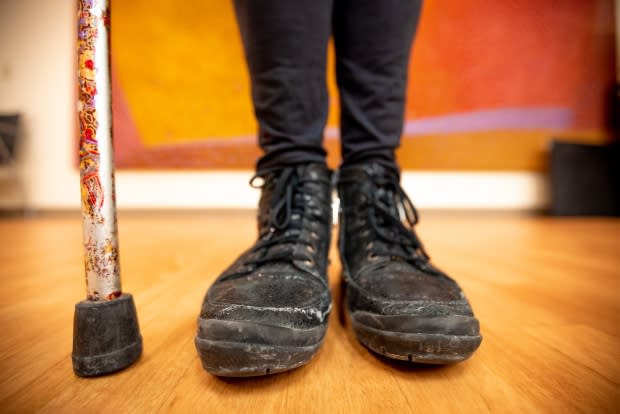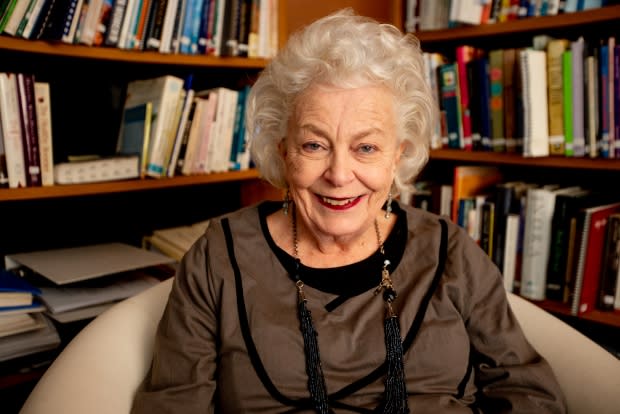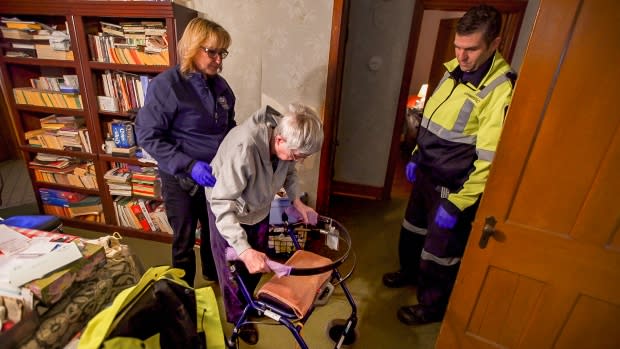An often-overlooked risk, the science of slips and falls can be life-saving
"All right," instructs the teacher. "Standing nice and tall. Use your chair for support please. With your right leg, we're going to lift it up to the side: one, two, three, four five. And again."
Erin Harris goes through the movements: The 74-year-old stands behind a chair and slowly stretches her left leg, before repeating the movement with the right.
Harris is taking part in a falls-prevention class at the Toronto Rehabilitation Institute, along with about a half-dozen other seniors. Some in the room, like Harris, have experienced a bad fall and are here to try to prevent the next one from happening.
To do so, they learn about the benefits of exercise, how to get up from a fall, stair safety, healthy eating and overcoming the fear of falling. The 12-week program, which was first launched in 2013, is part group education, part exercise sessions.
Harris never thought she'd end up in a class like this. She was fit and active all her life. "I took four buses to go to skating lessons, one bus to go to ballet … played tennis, rode my bike, skied from the age of four."
But a tumble down a flight of stairs later in life, at age 67, changed all of that. "I was walking five miles a day forever — and it went down to one street," she said, recalling how much less she was able to walk after the fall.

According to the Canadian Institute for Health Information (CIHI), unintentional falls were the most common form of injury across the country in 2017, resulting in nearly 1,800 emergency-room visits each day. In all, falling was responsible for 32 per cent of all reported ER visits that year, the agency says, costing the health-care system more than $2 billion.
Seniors are the most vulnerable. In addition to being at a higher risk of falling, they also take a longer time to recover from their injuries.
Falls Intervention Team
In Ontario's Niagara region, the regional emergency medical services (EMS) says it has seen a rise in the number of calls related to seniors who've fallen.
In response, officials have come up with an innovative approach to deal with the issue. Last July, a special mobile unit — called the Falls Intervention Team — was created. Pairing a paramedic with an occupational therapist, the team is dispatched exclusively to 911 calls from seniors who have fallen.
"By seeing our patients in the environment of the fall and seeing first-hand the circumstances that provoked the fall, the team can often better understand the root cause," said Karen Lutz, quality assurance commander with Niagara EMS.
"Paramedics aren't experts in falls prevention, but occupational therapists often are. By uniting the disciplines, we can do a better job of being more proactive when people fall in order to prevent the next one."

When the falls team isn't responding to emergency calls, it checks in on seniors who've fallen previously — so-called "frequent fallers." During a recent visit with one woman, occupational therapist Leslie Yole used the opportunity to give the 71-year-old a few pointers on how to get up from a spill safely.
"She's an older person," said Yole. "She doesn't have a lot of social support. She's quite clear that she wants to stay in her home, but she appreciates that she wants to be safe in her home."
It's still early, but officials in Niagara feel they're already making a difference: they say there have been fewer visits to the emergency rooms.
And while the program doesn't promise to prevent the first fall, its goal is to make sure there are no further ones.
The science of falls
And beyond the hospital, researchers at Simon Fraser University in Burnaby, B.C., have been studying the science of falls in older adults.
"It's a huge cause of injury and death," said Stephen Robinovitch, an engineer and lead researcher with the school's Injury Prevention and Mobility Laboratory. "That's one of the things that motivates me."
The focus of Robinovitch's work is on the two most important injuries related to falls: hip fractures and traumatic brain injury.
"We're trying to prevent the next fall from happening, but maybe more specifically, we're also trying to prevent injury in the event of a fall," he said.

According to Robinovitch, falls are the cause of 90 per cent of hip fractures in older adults, and some of the work they're doing is trying to solve that problem. For example, Robinovitch and his team have tested several kinds of protective padding, coming up with a design for a wearable hip protector for seniors that fits into an undergarment.
Seniors in 14 nursing homes in the Vancouver area already are wearing the hip protectors, Robinovitch says, and so far, it has reduced hip fractures by one-third in those facilities.
The researchers are also testing different textures of floor surfaces, with the aim of making them easier for seniors to navigate. They study real-life falls from long-term care facilities in the Vancouver area, providing valuable insight into how and why falls occur in older adults.
SFU researchers rely on footage from Vancouver's care homes for insight into falls:
"A combination of real-life falls in those high-risk environments and our studies here in the lab ... allows us to gain insight on why every fall is not a disaster," said Robinovitch.
Bathroom 'one of the most dangerous areas of home'
In 2017, falls in the home accounted for about 115,000 emergency department visits, making it the most common location for a fall, according to CIHI.
And one of the main culprits is the bathroom, with all of its hard and slippery surfaces: More than 70 per cent of falls happen getting in and out of the tub.
"The bathroom is such a high-risk environment," said Alison Novak, a scientist with the Toronto Rehabilitation Institute, who also researches fall prevention. "It's one of the most dangerous areas of the home."
Making the bathroom safer for seniors is part of Novak's work.
"Because we have declines in our physiological capacity, we have declines in balance control," she explained. "So as you step over a large obstacle, like a bathtub rim, you are placed at a greater risk of fall."

Part of her research is focused on grab bars, asking questions like: Should they be present? Should they be mandatory? If they are mandatory, where should they be placed?
In a simulated bathroom, Novak and her team are trying to find answers to those questions, while also trying to quantify how many falls could potentially be avoided.
To conduct the research, a 73-year old volunteer is placed in a harness and then instructed to step in and out of a slippery tub. By inducing a shake in the floor, which forces the volunteer to slip, Novak can study how quickly he is able to recover by holding on to the bar.
"Bathing disability is a huge issue and it's one of the primary reasons an older adult will have to leave their home. If we really do want to support the idea of aging in place, the bathroom is one of those areas we have to address," said Novak.
As for Erin Harris, it took her several weeks to recover from the broken ankle she experienced after falling in her Toronto condo building. These days, she still relies on a cane to get around, but is determined not to fall ever again.
The classes she's been taking at Toronto Rehab have helped her restore her self-confidence, she says.
"It allowed me to focus on my balance, my flexibility, my adaptability to change. And I was very grateful for that."

